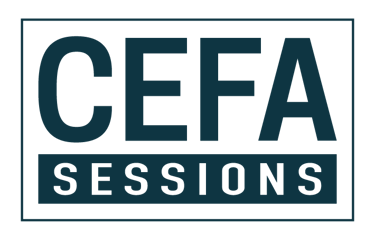Foro de Economía Circular de las Américas
CEFA reúne a líderes de la industria, emprendedores, universidades, ONG y gobiernos de todo el hemisferio occidental. Su objetivo es facilitar debates de alto nivel con expertos y profesionales clave en Economía Circular para debatir el estado de las necesidades, los desafíos y las oportunidades de este importante campo de trabajo en rápida expansión. Con el objetivo de generar una comprensión común y más profunda de la Economía Circular y su relevancia y aplicabilidad en la región.
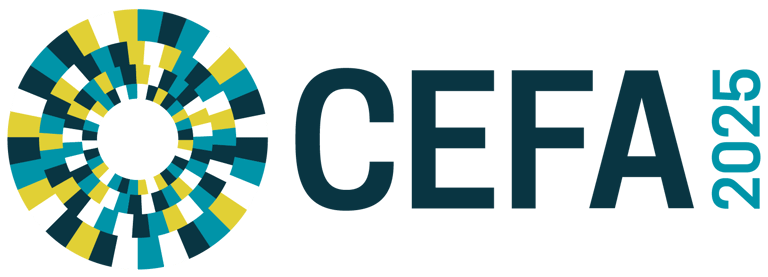

1 - 4 de diciembre de 2025 | El Retiro, Antioquia - Colombia
Una edición especial de CEFA
Para celebrar la 5.ª edición de CEFA, ¡organizamos un retiro especial de 3 días para CEFA2025!
CEFA2025 se llevará a cabo en un espacio único, “El Silicon Valley”, ubicado a aproximadamente una hora de Medellín, rodeado de naturaleza y paisajes hermosos e inspiradores, con todas las comodidades para una experiencia maravillosa. Este evento presencial e íntimo incluye un programa que permite paneles de discusión interactivos, diálogos individuales, grabaciones de podcasts, presentaciones de alto nivel y amplio espacio para establecer contactos e intercambios intelectuales profesionales.
Nuestro invitado destacado:
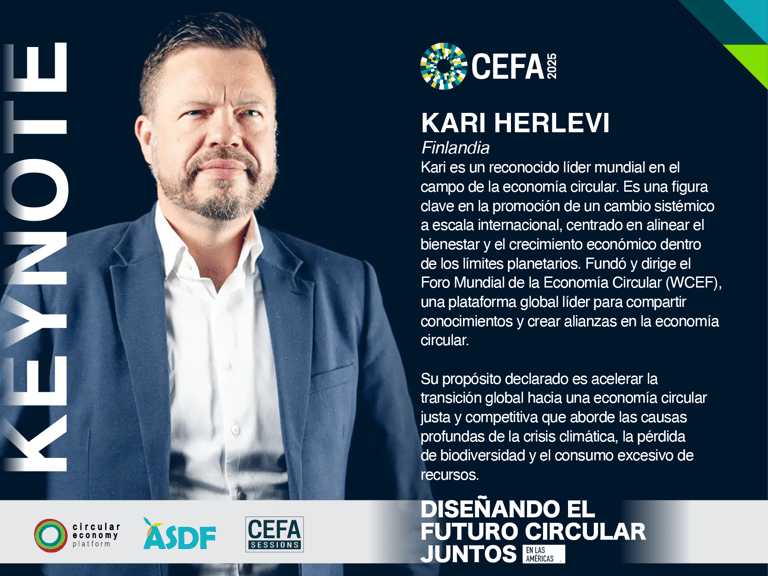


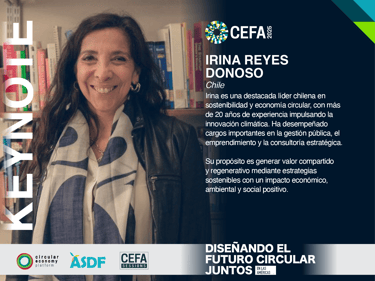


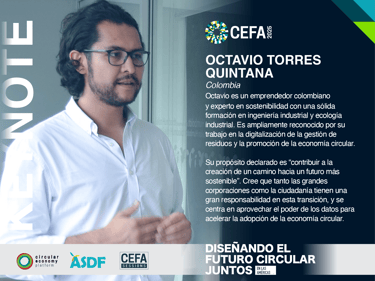

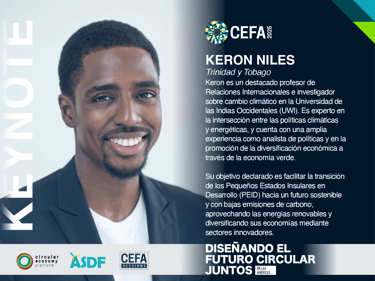

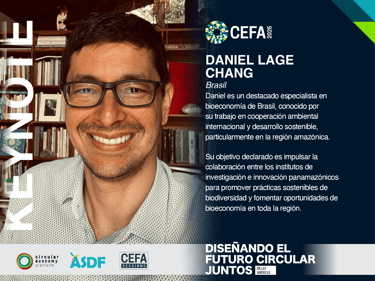

















Programa CEFA2025 - Retiro profesional de 3 días
Conozca la sede de CEFA de este año:
¡Agradecemos a "El Silicon Valley" por acogernos este año!
Inteligencia artificial y el futuro de la economía circular
1. Reciclaje más inteligente con IA.
¡Imagina contenedores de basura que piensan por sí mismos! Gracias a la IA y a los sensores inteligentes, ahora es posible clasificar los materiales y asignarles un valor con una precisión increíble. ¿Cómo podemos garantizar que estos sistemas optimicen las rutas de recogida, ahorren tiempo, reduzcan el consumo de combustible y las emisiones, a la vez que recuperan materiales más valiosos?
2. Pasaportes Digitales de Productos (DPP).
¿Qué pasaría si cada producto tuviera su propia "historia digital"? Los DPP lo hacen posible: muestran de dónde proviene un producto, de qué está hecho y cómo se puede reparar, reutilizar o reciclar. ¿Estamos preparados para adaptarnos a esta nueva tendencia?
3. Blockchain para la confianza y la trazabilidad.
La tecnología blockchain añade una capa adicional de confianza. Al rastrear de forma segura cada paso de la vida de un producto, desde la materia prima hasta el supraciclaje, blockchain garantiza que las afirmaciones de sostenibilidad sean reales, no solo palabras. ¿Podemos realmente generar confianza entre productores y consumidores, a la vez que protegemos el medio ambiente?
Transición hacia modelos de negocio circulares
1. Productos como Servicio (PaaS)
¿Para qué comprar cuando se puede usar de forma más inteligente? En lugar de poseer un producto, los clientes pueden suscribirse para usarlo, ya sean productos electrónicos, herramientas o incluso muebles. ¿Es cierto que este enfoque motiva a las empresas a diseñar productos más duraderos, fáciles de reparar y con un gran rendimiento a largo plazo?
2. Reacondicionamiento y refabricación
Lo viejo no significa obsoleto. Cada vez más empresas están dando una segunda vida a sus productos: reparándolos, actualizándolos y revendiéndolos como nuevos. Desde teléfonos hasta equipos industriales, esta práctica ahorra energía, reduce las emisiones y crea empleo. Pero ¿incentiva esto la economía circular?
3. Logística inversa y programas de recuperación
Imagina un mundo donde los productos no terminen en vertederos, sino que regresen a la empresa que los fabricó, listos para ser reparados, reutilizados o supra-reciclados. ¿Cuánto podemos lograr mediante la logística inversa?
1. Materiales de origen biológico y modulares
La naturaleza se está convirtiendo en nuestra nueva fábrica. Desde algas y hongos hasta residuos agrícolas, científicos y diseñadores están creando nuevos materiales que sustituyen a los plásticos y reducen la dependencia de los combustibles fósiles. ¿Tiene futuro la bioeconomía circular?
2. Diseño para la durabilidad y el desmontaje
Los productos del futuro están diseñados para durar y ser fáciles de reparar. El diseño modular facilita la reparación o actualización de artículos en lugar de desecharlos. También garantiza la recuperación de componentes valiosos al final de su ciclo de vida. ¿Realmente estamos diseñando para la circularidad?
3. Reciclaje de nueva generación
El reciclaje está evolucionando rápidamente. Más allá de los métodos mecánicos, las nuevas tecnologías de reciclaje químico y enzimático pueden descomponer los materiales en sus moléculas básicas, lo que permite reciclar plásticos, textiles y otros materiales una y otra vez sin perder calidad. ¿Nos acercará esto a un mundo de ciclos de materiales verdaderamente infinitos?
Diseño de productos circulares e innovación de materiales
Los temas de este año...
Para esta edición del CEFA contamos con estas ofertas exclusivas:
Curso de introducción a la Economia Circular Sostenible
Curso de 1 día: Introducción a la Economía Circular Sostenible (individual)
Fecha: Lunes, 1 de diciembre de 2025
Hora: 9:30 a. m. - 6:30 p. m.
Ubicación: Km. 27 Vía Las Palmas VDA Los Salados URB Ziruma CA 121
Incluye: Almuerzo y cena, café y refrigerios todo el día.
Inversión:
COP 700.000 (pesos colombianos) IVA incluido, para 1 persona.
Retiro CEFA2025
(Inversión individual)
Retiro de 3 días: Economía Circular para Profesionales (individual)
Fecha: Martes, 2 de diciembre de 2025 a jueves, 4 de diciembre de 2025
Ubicación: Km 27 Vía Las Palmas VDA Los Salados URB Ziruma CA 121
Incluye: 3 noches de alojamiento, desayuno, almuerzo y cena, café y refrigerios durante todo el día.
**Fecha de llegada: 1 de diciembre de 2025 después de las 15:00 h.
Inversión:
Antes del 28 de noviembre de 2025: COP4.750.000 (Pesos Colombianos) IVA incluido, para 1 persona.
Retiro CEFA2025
(2 personas por empresa u organización)
Retiro de 3 días: Economía Circular para Empresas (2 personas)
Fecha: Martes, 2 de diciembre de 2025 a jueves, 4 de diciembre de 2025
Ubicación: Km 27 Vía Las Palmas VDA Los Salados URB Ziruma CA 121
Incluye: 3 noches de alojamiento, desayuno, almuerzo y cena, café y refrigerios durante todo el día.
**Fecha de llegada: 1 de diciembre de 2025 después de las 15:00 h.
Patrocinio:
Antes del 28 de noviembre de 2025: COP 8.000.000 (pesos colombianos) IVA incluido, para 2 personas en nombre de la empresa/organización.
¿Quieres unirte a esta edición única de CEFA?
Curso introductorio de un día sobre la "Economía Circular Sostenible" en CEFA2025


Retiro profesional CEFA2025 de 3 días
Sede del CEFA2025
Ubicación:
Km 27 Vía Las Palmas VDA Los Salados URB Ziruma CA 121 El
Retiro, Antioquia - Colombia
